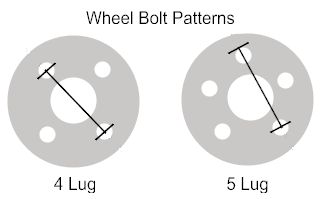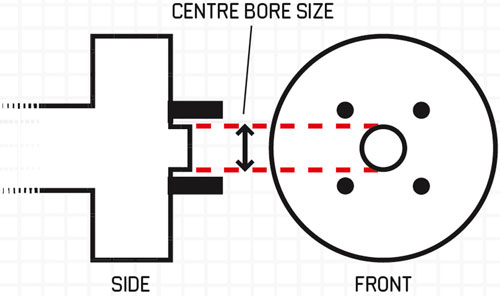Offset
The offset of a vehicle's wheel is the distance between the centerline of the wheel and the plane of the hub-mounting surface of the wheel. It can thus be either positive or negative, and is typically measured in millimeters. Offset has a significant effect on many elements of a vehicle's suspension, including suspension geometry, clearance between the tire and suspension elements, the scrub radius of the steering system, and visually, the width of the wheel faces relative to the car's bodywork.
Offset is the location of the flat mountin surface of a wheel relative to the wheel's centerline. Negative offset means that the mounting surface is toward the center of the car, postive offset means that it's toward the ouside of the car, or the wheel is "pulled in" toward the center. Offset affects many things other than just whether the wheel has the appearance of "sticking out" past the fender. The wrong offset can causerubbing problems when the suspension is compressed of the wheel is turned. Offset affects the steering geometry's scrub radius, possibly leading to problems with torque steer or self-centering characteristics.
Offset also affects the suspension's motion ratio, which directly determines the effective spring and damper rates. Potentially, in a very heavily loaded vehicle, or with extreme changes in offset, wheel bearing life can be affected, but this is more often talked about by truck people than by small car enthusiasts. It is very, very important that the proper offset wheel be used.
While not directly a matter of offset, brake caliper clearance is a related issue. If you have, or plan t have big brakes on your car, be sure that you wheels that you are going to use, will fit over the calliper. Spacers are available to solve the problem if they don't, but it is best to get a wheel with enough dish to met your offset specs and still fit your brakes. Consulting the wheel and brake manufacturers ahead of time is wise. Many aftermarket brake companies even have templates of their brakes available that you can easily check against any wheel.
An average deviation of 5 mm is acceptable.
- A positive (+) offset is when the mounting surface is shifted from the centerline toward the front or outside of the wheel.
- A negative (-) offset is when the mounting surface is toward the back or brake side of the wheel's centerline.
- A zero offset is when the mounting surface is in the plane of the centerline.
Negative offsets are considered aggressive, since the mounting surface of the wheel will "hit the hub of your car much quicker, hence the wheel will stick out more."
What is wheel offset?
Basic explanation
How to measure wheel offset
All you need to measure tire offset
GUIDE to Offset, Lug Pattern, Wheel/Tires Specs
Finally a video explaining EVERYTHING about wheels and fitment.

Bolt Pattern/Pitch Circle Diameter (PCD)
PCD (Pitch Circle Diameter) is the measurement of the diameter of the imaginary circle drawn through all of the wheel bolts or studs on a wheel. It is also known as the 'bolt circle'. A wheel's PCD is usually displayed after the number of studs, separated by a slash. Hence a 'pcd' of 5/120 means...

Centre Bore
The centre bore is the size of the hole in the centre of the wheel where the spigot fits through. The centre bore, (also known as spigot size), is the diameter of this hole, usually measured in millimetres. For most road wheels, the weight of the car is transmitted from the...



